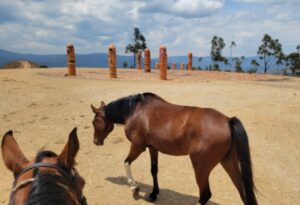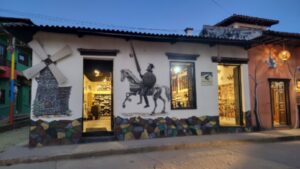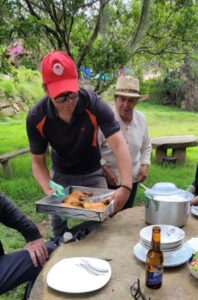Riding to and around Villa de Leyva
As with the Barichara ride, the scenery in this part of Colombia is beautiful and you get many chances to try the local cuisine and meet locals. If you haven’t been to Bogota before, then spend a couple of days there first. If you don’t live at a high elevation you can start getting to used to being at altitude.
The ride starts at Julio’s farm. After being picked up a your hotel it’s about 90 minutes to Julio’s farm where the horses for the trip are waiting. It’s much easier getting out of Bogota in the morning than getting in to the city in the afternoon. The farm is in a beautiful valley and it’s a great place to start your adventure, with the horses quickly warmed up and ready to trot and canter. Julio and Wilson pony extra horses so that there are spares during the week in the event of injury, tiredness of just a desire to ride a different horse.



The ride
The horses, a mixture of Arabians, Arabian/Criollo and Anglo Arab mixes, are fleet of foot, healthy and willing partners that behave well and keep an endurance pace when asked. The tack is excellent and picked for horse comfort, I took a sheepskin seat saver and I recommend them. Along with Julio there are two assistants: Wilson who is the groom and a wonderful horseman that not only assures the horses are well but rides at the rear; and on this ride Jhonmarc as the support driver who not only took care of the horses ( assuring we had sufficient water for the horses along the way) but brought out luggage, followed us on busy roads and stopped traffic for us when necessary. Caballo Por Colombia continue to be the most safety conscious outfit I have ridden with anywhere in the world; walkie-talkie and phone communication between the team, safety briefings, daily temperature checks, first aid kits, insurance (with wrist bands for all) and vehicle escorts for the horses/riders through town – 5 stars.
The terrain started with a climb to Crucero where we stopped for water and beers/sodas, and then onto lunch at Lake Suesca before leaving for the first night in Cucunuba. . Despite the climb there are lots of trots and extended canters. The trip generally heads north through dairy country, then hilly terrain as you enter Raquira,then high desert ( La Candalaria) and then down to the farm lands around Villa de Leyva. The desert day requires one very steep though short ascent, we dismounted and let the horses go up as the footing was a bit loose. Overall it’s a pretty ride with lots of scenic areas, wild flowers ( orchids were in bloom in late February) and native trees. Some of the villages have unique attributes including clay artisans in Raquira.
Rustic country food. Robust breakfasts to prepare for the long day- fruit (papaya,pineapple), juice (lulo, blackberry and orange) , eggs, local breads, hot chocolate and coffee. Lunches usually focused on local specialties – chaufa a rice dish, ajiaco soups, a couple of days we were so remote we took sandwiches. Dinners were not for the dieter trout, pork, chicken and more – and not to forget beers, aguadiente and chocolate/pastry breaks. Water was plentiful with lots of opportunities to refill bottles.
This is a ride for fit riders used to a fast pace, especially good for endurance riders. It is not appropriate for riders who spend a couple of leisurely hours a week meandering through the countryside or riding around in an arena.



Accommodation
The first and last night are spent in a small hotel in Bogota, clean and simple, take ear plugs though. The hotel is in a good area for restaurants and walking around, and they have their own drivers to/from the airport which is great. All of the places we stayed were clean and comfortable, ranging from small hotels to private country houses. Usually a night is spent at the La Candelaria Monastery, but there was a monk’s offsite (I’m not kidding) so we spent the night at a lovely private house outside Raquira. The last 2 nights of the ride are usually at the Hacienda Flamingo, just outside Villa de Leyva great location and wonderful pastures for the horses. Wifi was available everywhere so easy to keep in touch and the cell signal was better than I get in California most of the time.
Culture
This ride offers many opportunities to see the local villages and you will most likely be the only foreign tourists. From traveling through the farmlands of Ubate, to staying at the Hacienda Ticha – a beautiful old hacienda dating back to the late 1700s; in the 1800s it belonged to Juan José Neira a general in the Colombian army who fought along side Simon Bolivar for independence. The town of Raquira is famous for it’s pottery, along with the worlds’ largest piggy bank which you will see as you leave the next morning. Other highlights include crossing the La Candelaria desert, visiting the La Candelaria Monastery and the town of Villa de Leyva.



Villa de Leyva
Probably the best preserved Colonial town in south America, Villa de Leyva was declared a National Monument in 1954, it’s on the tentative list for a Unesco World Heritage site – which it definitely deserves. The town square, Plaza Mayor, is enormous and is believed to be the largest completely cobbled town square in South America. There are lots of little shops, restaurants and coffee bars. One of the oldest hotels there, the Posada de San Antonio – across three restored colonial homes – is available for longer stays (it’s owned by the same people who own the Hacienda Flamingo.)



Before you go:
- Contact Julio at Acaballo por colombia to get an up-to-date calendar and pricing
- If you are going in a couple of days early I can recommend a good guide for Bogota
- The traffic in Bogota is horrendous, leave lots of time to get into/out of and around Bogota
- If you live at sea level remember to leave time to adjust to the elevation
- You can bring coffee, chocolate, pottery, linens, rum and aguadiente back to the USA
- Bogota airport can be slow, especially for arrivals
- No matter the season take waterproof riding jackets
- I recommend a seat saver
- Water bottles are provided.
- You will be required to buy travel/health insurance
- Tipping is OK in US dollars, but local towns and merchants require colombian pesos – get from an ATM or the airport
In summary: I unequivocally recommend this trip for adventurous, fit (endurance) riders






